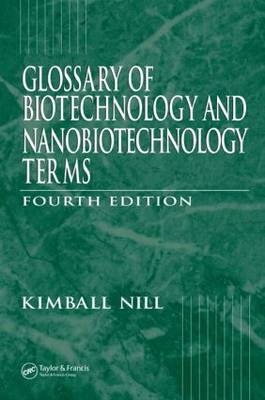
Glossary of Biotechnology Terms, Fourth Edition
Seiten
2005
|
4th New edition
Crc Press Inc (Verlag)
978-0-8493-6609-3 (ISBN)
Crc Press Inc (Verlag)
978-0-8493-6609-3 (ISBN)
- Titel erscheint in neuer Auflage
- Artikel merken
Zu diesem Artikel existiert eine Nachauflage
As the fields of biotechnology and nanobiotechnology continue their growth and evolution, non-technical people must quickly become conversant with a topic that is highly technical. This title shows the nanotechnology terms relevant to biotechnology. It provides definitions of terms, clarifies fresh terms, and describes how they are used.
Even if you studied biotechnology in school, if you haven't stayed current, it's not likely you'll be able to speak the same language as today's biotech scientists. The same is even truer for nanotechnology where everything gets smaller and smaller, except the terminology required to navigate it.
In the Glossary of Biotechnology and Nanobiotechnology Terms, Fourth Edition, Kimball Nill continues to improve upon the reference that for over a decade has helped thousands of professionals, including scientists, attorneys, government workers, lobbyists, venture capitalists, and university tech transfer staff, to communicate successfully with those working on the cutting edge of modern science. Now in its fourth edition, Nill has taken the much appreciated step of adding nanotechnology to his glossary.
Just by casually perusing the Glossary of Biotechnology and Nanobiotechnology Terms, Fourth Edition you will learn a number of enlightening facts. Even those in related sciences will be surprised to discover what the language unveils.
The Glossary of Biotechnology and Nanobiotechnology Terms, Fourth Edition is a handy reference designed for people with little or no training in the biological and chemical sciences, as well as scientists communicating from other disciplines. Unlike other glossaries, this one is both informative and completely accessible. Instead of looking up one term to end up mired in equally difficult terminology, this intelligently designed volume follows what the author refers to as a Reference Chain that steadily leads you to simpler more common terminology, down to a level that anyone with a high school education will be able to understand.
The definitions are written utilizing words that enable you to conceptualize the idea embodied in the term, with explanations based on analogy whenever possible.
Consider this example:
Suppose you just received a funding request, a faculty memo, or patent concern that refers to A-DNA, which happens to be the first definition in the Glossary.
A-DNA
A particular right-handed helical form
of DNA (possessing 11 base pairs per turn),
which is the form that DNA molecules exist
in when they are partially dehydrated. A-form
DNA is found in fibers at 75% relative humidity
and requires the presence of sodium, potassium,
or cesium as the counterion. Instead of
lying flat, the bases are tilted with respect to
the helical axis, and there are more base pairs
per turn. The A-form is biologically interesting
because it is probably very close to the
conformation adopted by DNA-RNA hybrids
or by RNA-RNA double-stranded regions.
The reason is that the presence of the 2'2 hydroxyl
group prevents RNA from lying in
the B-form.
See also B-DNA, DNA-RNA HYBRID,
DEOXYRIBONUCLEIC ACID (DNA),
BASE PAIR (bp)
But then after looking at the above definition, you wonder what exactly is a DNA-RNA Hybrid?
DNA-RNA Hybrid A double helix that consists
of one chain of DNA hydrogen-bonded
to a chain of RNA by means of complementary
base pairs.
See also HYBRIDIZATION (MOLECULAR
GENETICS), HYBRIDIZATION (PLANT
GENETICS), DOUBLE HELIX
…however while you've often heard mention of a double helix, you were never quite sure what that meant….
Double Helix The natural coiled conformation
of two complementary, antiparallel DNA
chains. This structure was first put forward by
Watson and Crick in 1953.
See also DEOXYRIBONUCLEIC ACID (DNA)
And that might brings you to ask, Do you really actually know what DNA is?
Deoxyribonucleic Acid (DNA)
Discovered
by Frederick Miescher in 1869, it is the chemical
basis for genes. The chemical building
blocks (molecules) of which genes (i.e.,
paired nucleotide units that code for a protein
to be produced by a cell's machinery, such as
its ribosomes) are constructed. Every inherited
characteristic has its origin somewhere in
the code of the organism's complement of
DNA. The code is made up of subunits called
nucleic acids. The sequence of the four
nucleic acids is interpreted by certain molecular
systems in order to produce the proteins
required by an organism. The structure of the
DNA molecule was elucidated in 1953….
The Glossary of Biotechnology and Nanobiotechnology Terms, Fourth Edition is packed with over 400 pages of exceptionally well-organized and cross-referenced terminology, making it an essential reference for anyone working directly or indirectly with those pioneering the frontiers of modern biology.
Even if you studied biotechnology in school, if you haven't stayed current, it's not likely you'll be able to speak the same language as today's biotech scientists. The same is even truer for nanotechnology where everything gets smaller and smaller, except the terminology required to navigate it.
In the Glossary of Biotechnology and Nanobiotechnology Terms, Fourth Edition, Kimball Nill continues to improve upon the reference that for over a decade has helped thousands of professionals, including scientists, attorneys, government workers, lobbyists, venture capitalists, and university tech transfer staff, to communicate successfully with those working on the cutting edge of modern science. Now in its fourth edition, Nill has taken the much appreciated step of adding nanotechnology to his glossary.
Just by casually perusing the Glossary of Biotechnology and Nanobiotechnology Terms, Fourth Edition you will learn a number of enlightening facts. Even those in related sciences will be surprised to discover what the language unveils.
The Glossary of Biotechnology and Nanobiotechnology Terms, Fourth Edition is a handy reference designed for people with little or no training in the biological and chemical sciences, as well as scientists communicating from other disciplines. Unlike other glossaries, this one is both informative and completely accessible. Instead of looking up one term to end up mired in equally difficult terminology, this intelligently designed volume follows what the author refers to as a Reference Chain that steadily leads you to simpler more common terminology, down to a level that anyone with a high school education will be able to understand.
The definitions are written utilizing words that enable you to conceptualize the idea embodied in the term, with explanations based on analogy whenever possible.
Consider this example:
Suppose you just received a funding request, a faculty memo, or patent concern that refers to A-DNA, which happens to be the first definition in the Glossary.
A-DNA
A particular right-handed helical form
of DNA (possessing 11 base pairs per turn),
which is the form that DNA molecules exist
in when they are partially dehydrated. A-form
DNA is found in fibers at 75% relative humidity
and requires the presence of sodium, potassium,
or cesium as the counterion. Instead of
lying flat, the bases are tilted with respect to
the helical axis, and there are more base pairs
per turn. The A-form is biologically interesting
because it is probably very close to the
conformation adopted by DNA-RNA hybrids
or by RNA-RNA double-stranded regions.
The reason is that the presence of the 2'2 hydroxyl
group prevents RNA from lying in
the B-form.
See also B-DNA, DNA-RNA HYBRID,
DEOXYRIBONUCLEIC ACID (DNA),
BASE PAIR (bp)
But then after looking at the above definition, you wonder what exactly is a DNA-RNA Hybrid?
DNA-RNA Hybrid A double helix that consists
of one chain of DNA hydrogen-bonded
to a chain of RNA by means of complementary
base pairs.
See also HYBRIDIZATION (MOLECULAR
GENETICS), HYBRIDIZATION (PLANT
GENETICS), DOUBLE HELIX
…however while you've often heard mention of a double helix, you were never quite sure what that meant….
Double Helix The natural coiled conformation
of two complementary, antiparallel DNA
chains. This structure was first put forward by
Watson and Crick in 1953.
See also DEOXYRIBONUCLEIC ACID (DNA)
And that might brings you to ask, Do you really actually know what DNA is?
Deoxyribonucleic Acid (DNA)
Discovered
by Frederick Miescher in 1869, it is the chemical
basis for genes. The chemical building
blocks (molecules) of which genes (i.e.,
paired nucleotide units that code for a protein
to be produced by a cell's machinery, such as
its ribosomes) are constructed. Every inherited
characteristic has its origin somewhere in
the code of the organism's complement of
DNA. The code is made up of subunits called
nucleic acids. The sequence of the four
nucleic acids is interpreted by certain molecular
systems in order to produce the proteins
required by an organism. The structure of the
DNA molecule was elucidated in 1953….
The Glossary of Biotechnology and Nanobiotechnology Terms, Fourth Edition is packed with over 400 pages of exceptionally well-organized and cross-referenced terminology, making it an essential reference for anyone working directly or indirectly with those pioneering the frontiers of modern biology.
Glossary Format, A to Z
| Erscheint lt. Verlag | 16.11.2005 |
|---|---|
| Verlagsort | Bosa Roca |
| Sprache | englisch |
| Maße | 178 x 254 mm |
| Gewicht | 862 g |
| Themenwelt | Technik ► Umwelttechnik / Biotechnologie |
| ISBN-10 | 0-8493-6609-7 / 0849366097 |
| ISBN-13 | 978-0-8493-6609-3 / 9780849366093 |
| Zustand | Neuware |
| Haben Sie eine Frage zum Produkt? |
Mehr entdecken
aus dem Bereich
aus dem Bereich
Kommentar der DIN 15905-5, LärmVibrationsArbSchV und …
Buch | Softcover (2023)
DIN Media (Verlag)
58,00 €
Buch | Softcover (2023)
DIN Media (Verlag)
75,40 €
Buch | Softcover (2024)
Pearson Education Limited (Verlag)
75,95 €



